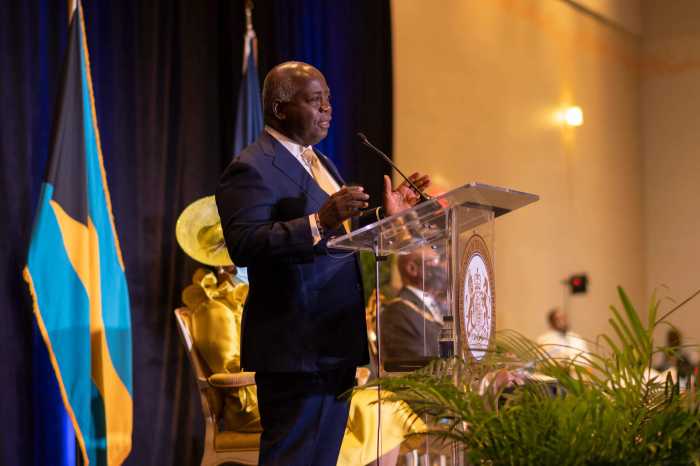Governor Andrew Cuomo at last June's Pride Parade announcing New York’s commitment to a plan to effectively end the AIDS epidemic by 2020. | GAY CITY NEWS
While advocates were looking for tens of millions of dollars or more in the final state budget to pay for the plan to reduce new HIV infections in New York to 750 annually by 2020, the final state budget contains little new money to fund the plan.
“We’re definitely well short of where we want to be,” said Charles King, president of Housing Works, an AIDS group, and the co-chair of the task force that drafted the plan.
The state budget will spend $5 million to fund a pre-exposure prophylaxis (PrEP) program at the state AIDS Institute, a unit of the state health department. The PrEP program, which gives anti-HIV drugs to HIV-negative people to keep them uninfected, will pay for insurance co-pays, the quarterly testing that people on PrEP must take, and other expenses. The PrEP program was made a permanent part of the budget. The AIDS Institute received another $5 million to fund other components of the plan. That second pot of cash is good for five years.
Albany agrees to $10 million where tens of millions sought, better news on runaway youth, LGBT health network
“It’s $10 million, which is not nearly enough, but it’s a longterm commitment,” King said.
Governor Andrew Cuomo endorsed the plan last year. Recent press reports have noted that Cuomo has taken to championing various causes, such as ethics reform or legislation that would give the children of undocumented immigrants access to state funds for higher education, and then not including them in legislative packages or not funding them adequately. The plan to end AIDS appears to be suffering the same fate.
On a February 26 appearance on “Capital Tonight,” an Albany cable news channel program, King said that $104 million in the state budget would be a “dream number,” but he told Gay City News that that dollar amount assumes that all sorts of other funding is in place as well.
The plan relies on PrEP, post-exposure prophylaxis (PEP), anti-HIV drugs taken by an HIV-negative person with a recent exposure to the virus to prevent infection, and treatment as prevention (TasP), which involves HIV-positive people taking medication so they are not infectious. All three of these so-called biomedical interventions are highly effective when taken correctly.
The Cuomo administration, which is emphasizing biomedical interventions to make the plan succeed, won reduced HIV drug prices with manufacturers last year. The plan was nearly derailed when a legal office in the state health department determined that the governor lacked the authority to negotiate those deals. In the budget, the Legislature gave Cuomo that authority through 2020.
“That ended up being a very hard fought battle,” King said.
Among the complaints from legislators was that the Cuomo administration had not released the final version of the task force’s draft plan and so there was no roadmap showing how the state could reduce the current 3,000 new HIV infections annually to 750 by 2020.
“We have been told that the governor is personally committed to doing an event,” King said, referring to the Cuomo administration releasing the blueprint. That event may happen in late April. When the plan is released, advocates can return to the Legislature and seek additional funds or changes in laws that they believe are necessary for success.
Other elements of the plan that were in the proposed budget, which was released in January, were retained. They include $116 million item to build 5,000 housing units over five years for people with special needs, people with HIV, and the homeless. Another $27 million will be used for rental assistance for people with HIV. Those dollars are from a one-time $440 million settlement from a lawsuit.
Advocates have long pointed to data demonstrating that housing stability increases treatment compliance, which in turn contributes to a positive person achieving an undetectable viral load at which point they are essentially not infectious to sexual partners.
The budget, which is for the fiscal year that began on April 1, partially decriminalizes possessing syringes; advocates sought full decriminalization. It bars police and prosecutors from using condoms as evidence when the person possessing the condoms is charged with a misdemeanor or violation; advocates wanted to ban using condoms as evidence entirely.
AIDS groups will be turning their attention to the city budget for the fiscal beginning on July 1, and they will be seeking new cash from the de Blasio administration for new programs.
“We think these new initiatives should be funded with new money,” King said.
In 2013, 95 percent of the new HIV diagnoses in New York were in New York City so the plan will not succeed without the city’s participation.
Separately, the Empire State Pride Agenda (ESPA), the statewide LGBT lobbying group, said that the budget “nearly doubles the amount of funding for Runaway and Homeless Youth to $4.48 million” and that the Lesbian, Gay, Bisexual and Transgender Health Initiative, which is funded by the AIDS Institute, had maintained funding at $4.97 million. The runaway and homeless youth funding had been cut by $4.0 million since 2008.
“This is the first appreciable increase in funding for runaway and homeless youth since 2008 and represents years of advocacy,” said Nathan M. Schaefer, ESPA’s executive director, in a written statement. “As a result, fewer kids will be forced to fend for themselves on New York’s streets or to resort to survival sex just to find a warm place to sleep at night.”



































